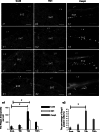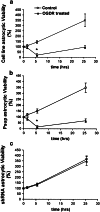The role of connexin 43 and hemichannels correlated with the astrocytic death following ischemia/reperfusion insult
- PMID: 23328809
- PMCID: PMC11498013
- DOI: 10.1007/s10571-013-9906-y
The role of connexin 43 and hemichannels correlated with the astrocytic death following ischemia/reperfusion insult
Erratum in
- Cell Mol Neurobiol. 2013 May 33(4):587. Becker, David L [removed]
Abstract
The aim of this study was to investigate the role of connexin 43 (Cx43) and its hemichannel (HC1) in the death of astrocytes following ischemia/reperfusion (IR) or oxygen-glucose deprivation/reoxygenation (OGDR) insult. Wistar rats had their bilateral common carotid artery clamped for 1.5 h followed by 0, 4, and 24 h of reperfusion (n = 8 for each time point), respectively. All rats were sacrificed and Cx43, HC1, and caspase 3 (Casp3) in cerebral ischemic tissues were examined by immunohistochemistry and western blotting. Astrocytes cell line, astrocytes transduced with a retroviral empty vector (Psup astrocyte), or a Cx43-specific shRNA construct (shRNA astrocytes) were treated with OGDR insult for various periods. The viability of astrocytes was assessed by MTT assay. The expression of Cx43, HC1, and Casp3 was detected with western blotting. The results showed that the expression of Cx43, HC1, and Casp3 in rats' brain, astrocytes, and Psup astrocytes was significantly increased after 4 h of IR/OGDR and recovered on 24 h of the insult. Cell viability decreased after 4 h of the insult whereas the cell viability increased on 24 h after the insult. In contrast, the expression of Cx43, HC1, Casp3, and cell viability had no statistical differences in the null Cx43 gene-shRNA transfected astrocytes after the treatment of OGDR. The results suggest that Cx43 and HC1 are likely to play the pivotal roles in the mediation of the astrocytic death.
Figures






References
-
- Benjelloun N, Joly LM, Palmier B, Plotkine M, Charriaut-Marlangue C (2003) Apoptotic mitochondrial pathway in neurones and astrocytes after neonatal hypoxia–ischaemia in the rat brain. Neuropathol Appl Neurobiol 29:350–360 - PubMed
-
- Carr AJ, Whitmore D (2005) Imaging of single light-responsive clock cells reveals fluctuating free-running periods. Nat Cell Biol 7:319–321 - PubMed
-
- Cooper CD, Solan JL, Dolejsi MK, Lampe PD (2000) Analysis of connexin phosphorylation sites. Methods 20:196–204 - PubMed
Publication types
MeSH terms
Substances
LinkOut - more resources
Full Text Sources
Other Literature Sources
Research Materials

